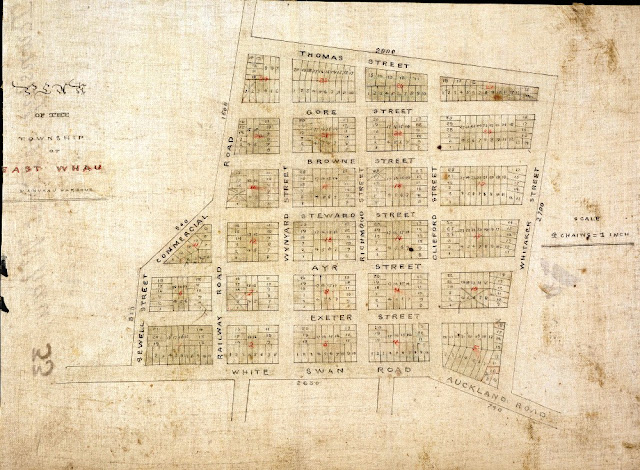"Looking south along Queen Street from the Wellesley St intersection, showing the premises of R H Bartlett, R Hobbs, F Hewin and Brother, the Army and Navy Hotel and the firebell tower on the corner of Greys Ave (centre)." [Detail, c.1875] Auckland Libraries Heritage Collections 4-67
Somewhere on the left side of this image, a man named King David Sykes started Auckland’s first Turkish Baths business.
He might not have been the first at all. An earlier planned Onehunga Turkish Baths company announced intentions with a hiss and a roar in the newspapers, with prospective directors shoulder-tapping prospective shareholders in the street.
“Several times I have been importuned by a very highly respectable timber agent in Auckland, to take a quantity of shares in the Great Onehunga Turkish Bath Dictating Company. The same gentleman tells me that the shares are in great demand, and will all very speedily be taken up, (£5 shares) as no doubt the Company will be one of the most successful ever started in the southern hemisphere. He knows the public will flock from Melbourne, Sydney, Dunedin, &c, to receive the benefits arising from the above establishment. Thus, sir, may be all very true; the antecedents of the gentleman would prevent me doubting his word, but I have not heard one single word of it through the papers - not one advertisement, and I have not even found it a subject of serious conversation in Onehunga.”
(Southern Cross, 8 January 1874)
The ads did appear, shareholders meetings were announced, but … it was all over a year later.
“The Turkish bath scheme at Onehunga has fallen through, owing in a very large measure to the unwillingness of Auckland people to cater heartily into a scheme for erecting baths on a site so far removed from the city, on which it would have to rely for support. Can nothing be done to revive such an admirable project?”
(Auckland Star, 7 January 1875)
Well, yes. Enter our man KD Sykes, a watchmaker by trade, originally from Manchester. By the beginning of September, Sykes had set up his own Turkish baths establishment, a few doors south of present day Airedale Street junction with Queen Street. In it he installed two “sudatoria” or sweating rooms, a tepid bath massage room, and cold water shower-bath. After that, the customer stretched out on a couch wrapped in towels until dry.
It started out as a men-only thing, but later on women were allowed to partake of the benefits on select “women only” days.
Sykes had an uphill battle. This was, of course, the height of the Victorian British Empire, with all the attitudes toward anything that involved naked adults in a public building.
“We learn that Mr K D Sykes is about to extend the Turkish Baths to meet the requirements of bathers. He also intends to reduce the prices, as the baths become more largely patronised. He informs us that he is not without hope that a public company may ultimately take the matter up and erect a hydropathic institution that will be a blessing to the public, and a credit to the city. Mr Sykes has fought the battle of the Turkish Bath against a good deal of ignorance and its value is becoming more generally recognised. He has shown a commendable determination to advance as circumstances justify, and improve his establishment. One of the chief advantages of Mr Sykes' baths is the fact that the proprietor, who has had great experience in hydropathic institutions is always in attendance, and bathers are thus preserved from the evil consequences which might result under an ignorant control. An apparatus is in course of construction to supply the baths with pure oxygen gas. Bathers will then come out like fairies, and frisk like kittens.”
(Auckland Star, 20 October 1877)
Sykes even renamed his business slightly and grandly, to the Auckland Turkish Bath and Hydropathy Institute. He had endorsements put into the newspapers from satisfied customers.
“In leaving Mr Svke's Establishment after a stay of eight weeks, I feel it my duty, both to him and the Publlc generally, to testify to the great success of the Turkish Bath in my case. In February last I had a severe attack of Rheumatic Fever, which left me in a helpless condition, and my friends thought I should never recover the use of my limbs. In Auckland I was recommended by a friend to take some Turkish Baths. I thought I would try them as a last resource, and feeling too weak to walk there I took a cab and called upon Mr Sykes, who advised me to place myself under Hydropathic treatment, and as my case was a bad one arrangements were made for me to reside in the house. After the first week I felt great relief, and continued to improve steadily every week. I have given Hydropathy a fair trial, and I now leave Auckland cured of Rheumatism and able to perform my duties. I have met friends in Auckland who look upon my recovery as a miracle. I may add that during my stay I witnessed many cures, three remarkable cases of Rheumatism, and leave others progressing favourably. My best thanks are due to Mr SYKES for his kindness and constant attention, and to Mr COGLAN the chief Bath attendant, for the cheerful and faithful manner in which he carried out his instructions. FREDK. JOHN BLAKE, Reserve Division, Armed Constabulary Force Cambridge, Waikato.”
(Auckland Star, 31 July 1879)
Sykes sold his enterprise to the Auckland Turkish Bath Company in 1881, and he retired to his home on Mt Eden Road, just across from Maungawhau Mount Eden. His house caught fire however in January 1886, and two weeks later King David Sykes, himself of a delicate constitution (a large part of the reason behind his fascination with Turkish baths) passed away.



